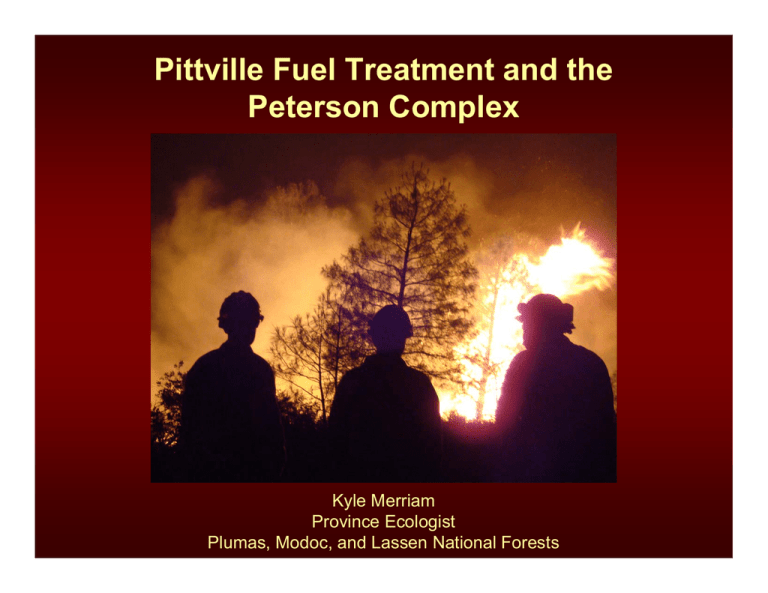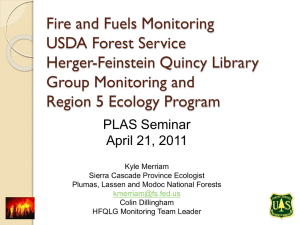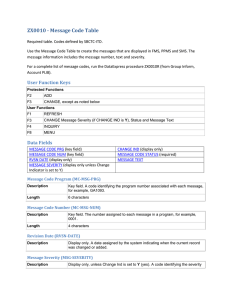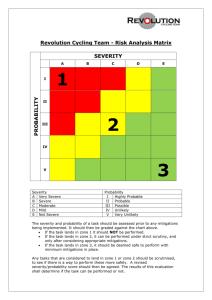Pittville Fuel Treatment and the Peterson Complex Kyle Merriam Province Ecologist
advertisement

Pittville Fuel Treatment and the Peterson Complex Kyle Merriam Province Ecologist Plumas, Modoc, and Lassen National Forests Fire Weather 80 9000 70 8000 7000 60 6000 50 Average Temp. (F) 5000 40 4000 Average Windspeed (mph) Min RH (%) Total Fire Size (acres) 30 3000 20 2000 10 1000 0 0 6/22/2008 6/23/2008 6/24/2008 6/25/2008 Date 6/26/2008 6/27/2008 Fire Size and Growth 9000 250 8000 7000 200 6000 150 5000 4000 100 3000 2000 1000 50 6/ 27 /2 00 8 6/ 26 /2 00 8 6/ 25 /2 00 8 6/ 24 /2 00 8 0 6/ 23 /2 00 8 6/ 22 /2 00 8 0 Fire Size (acres) Relative Growth (%) Was Fire Severity Influenced by the Pittville DFPZ? • Remote sensing data from satellite imagery • Field data collection Fire Severity Across Entire Peterson Complex High 31% Unchanged 25% Unchanged Low Moderate High Moderate 21% Low 23% Pittville DFPZ vs. Untreated Treated Untreated High 4% Low 24% Unchanged 67% Moderate 5% Unchanged 19% High 35% Moderate 23% Low 23% Severity by Treatment 700 600 Acres 500 400 Thin and Underburn Thin Only 300 200 100 0 High Moderate Severity Low Unchanged Field Data • Tree species, diameter at breast height, and tree height; • Overstory canopy closure; • Tree mortality; • Scorch height and bole char height; • Percent crown volume scorch; and • A categorical rating of burn severity. Severity Measures 0.9 0.8 0.7 Percent 0.6 0.5 Treated 0.4 Untreated 0.3 0.2 0.1 0 Scorch Char Crown Scorch Variable Mortality Catagorical Severity Rating 4 3.5 Rating 3 2.5 2 1.5 1 0.5 0 Treated Untreated Severity by Treatment Type 0.9 0.8 0.7 Percent 0.6 Thin Only 0.5 Thin and Burn 0.4 Untreated 0.3 0.2 0.1 0 Scorch Char Crown Scorch Variable Mortality Catagorical Severity Rating 4.5 4 3.5 Rating 3 2.5 2 1.5 1 0.5 0 Thin Only Thin and Burn Untreated Distance from the DFPZ Pittville DFPZ Untreated Factors Influencing Mortality • • • • • Distance from the DFPZ Slope Aspect Burn Day Vegetation Type Mortality with Distance and Slope 12 10 Mortality 8 0-5% 6-10% 6 11-20% >20% 4 2 0 0 50 100 150 200 250 300 Distance from DFPZ 350 400 450 500 Mortality with Distance and Burn Day 20 18 16 Mortality 14 12 23-Jun 10 24-Jun 8 6 4 2 0 0 50 100 150 200 250 300 Distance from DFPZ 350 400 450 500 Animal Sign 0.45 0.4 0.35 % of Plots 0.3 0.25 0.2 0.15 0.1 0.05 0 Treated Untreated Vegetation 2.5 Cover Class 2 1.5 Treated Untreated 1 0.5 0 Grass Herbs Vegetation Type Live shrubs Conclusions • Fire behavior modified within the Pittville DFPZ so that limited FS resources could concentrate elsewhere. • Fire severity within the Pittville DFPZ was lower than in adjacent untreated areas. Thinning and underburning treatments had lower fire severity than thinning only treatments. Conclusions, cont. Trees further inside the DFPZ had higher survival rates. Slope, aspect, and burn day also important, but not vegetation type. Other potentially important factors such as pre-fire fuel loads could not be measured. Conclusions, cont. Animal sign was statistically similar within the Pittville DFPZ compared with the adjacent untreated area. Without the Pittville DFPZ the Peterson Complex might have been at least 1,000 acres larger. More information Miller, J. D., H. D. Safford, M. Crimmins, and A. E. Thode. 2009. Quantitative Evidence for Increasing Forest Fire Severity in the Sierra Nevada and Southern Cascade Mountains, California and Nevada, USA. Ecosystems 12: 16-32. Miller, J.D. and H.D Safford. 2008. Sierra Nevada Fire Severity Monitoring 1984-2004. USDA Technical Report R5-TP-027. 102 pp. USDI National Park Service. 2003. Fire monitoring handbook. Boise (ID): Fire Management Program Center, National Interagency Fire Center. 274 pp. Acknowledgements • Field Assistants: Ingrid Burke, Tony Blair, Justin Tanner, and Ethan Morton. • Kit Mullen, District Ranger, Debbie Mayer, Fire Management Officer, and Engine 31, Hat Creek Ranger District, Lassen National Forest.





